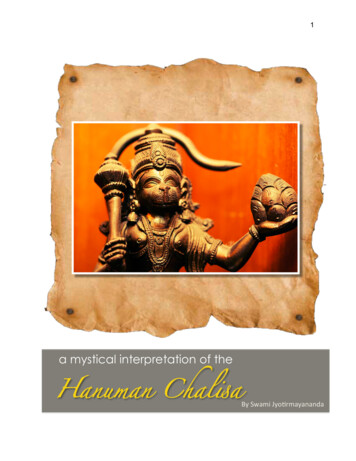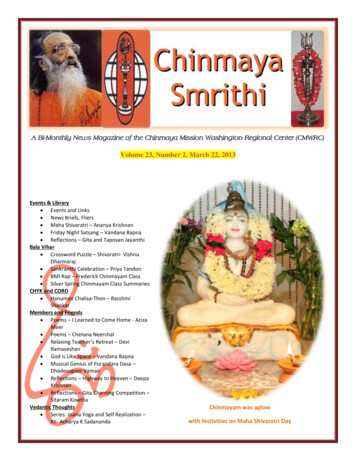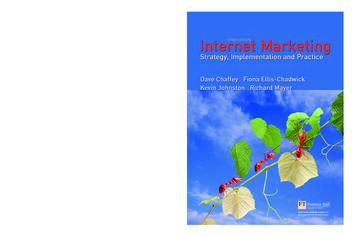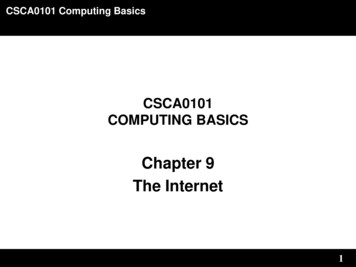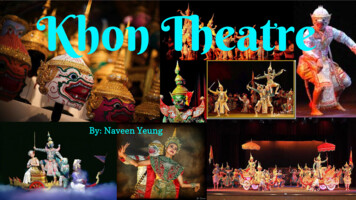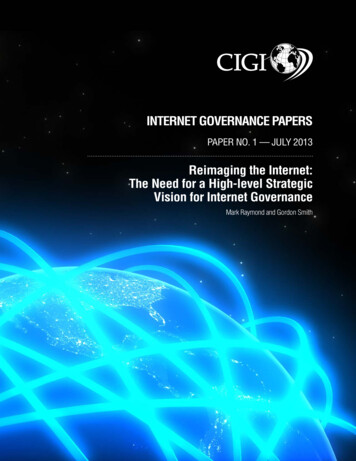
Transcription
myHANUMANCHALISA
myHANUMANCHALISADEVDUTTPATTANAIKIllustrations by the author
Published byRupa Publications India Pvt. Ltd 20177/16, Ansari Road, DaryaganjNew Delhi 110002Copyright Devdutt Pattanaik 2017Illustrations Copyright Devdutt Pattanaik 2017Cover illustration: Hanuman carrying the mountain bearing the Sanjivani herb while crushing the demonKalanemi underfoot.The views and opinions expressed in this book are the author’s own and the facts are as reported by himwhich have been verified to the extent possible, and the publishers are not in any way liable for the same.All rights reserved.No part of this publication may be reproduced, transmitted, or stored in a retrieval system, in any form or byany means, electronic, mechanical, photocopying, recording or otherwise, without the prior permission ofthe publisher.ISBN: 978-81-291-3770-8First impression 201710 9 8 7 6 5 4 3 2 1The moral right of the author has been asserted.This edition is for sale in the Indian Subcontinent only.Design and typeset in Garamond by Special Effects, MumbaiThis book is sold subject to the condition that it shall not, by way of trade or otherwise, be lent, resold, hiredout, or otherwise circulated, without the publisher’s prior consent, in any form of binding or cover otherthan that in which it is published.
To the trolls, without and within
ContentsWhy My Hanuman Chalisa?The TextThe ExplorationDoha 1: Establishing the Mind-TempleDoha 2: Statement of DesireChaupai 1: Why Monkey as GodChaupai 2: Son of WindChaupai 3: Thunder Body, Lightning MindChaupai 4: DarshanChaupai 5: Warrior, Servant, and SageChaupai 6: Rudra’s Eleventh FormChaupai 7: Clever and ConcernedChaupai 8: Other People’s StoriesChaupai 9: Adapting to ContextChaupai 10: Demon-killerChaupai 11: Saving LakshmanChaupai 12: A Brother Like BharatChaupai 13: Vishnu’s AvatarChaupai 14: Brahma and his Mind-born SonsChaupai 15: Admirers in Every DirectionChaupai 16: Enabling SugrivChaupai 17: Empowering VibhishanChaupai 18: Sun as FruitChaupai 19: MonkeynessChaupai 20: In Southeast AsiaChaupai 21: DoorkeeperChaupai 22: Guardian of FortuneChaupai 23: Three WorldsChaupai 24: Frightens Away GhostsChaupai 25: Takes Away AilmentsChaupai 26: Aligning with the Divine
Chaupai 27: Serving the Hermit-KingChaupai 28: Chariot of DesireChaupai 29: Four ErasChaupai 30: In ChinaChaupai 31: Goddess and TantraChaupai 32: Serving GodChaupai 33: Karma and RebirthChaupai 34: HeavensChaupai 35: One is ManyChaupai 36: Problem-SolverChaupai 37: Guru and GosainChaupai 38: LiberationChaupai 39: Title of the PoemChaupai 40: About the PoetDoha 3: Becoming HanumanFurther Reading & Acknowledgement
Why My Hanuman Chalisa?One of the things that catch your eye in the middle of a horrifyingly crowdedMumbai local train is the sight of people sitting or standing in a corner, readingfrom a tiny chapbook sold in roadside shops near temples. Most popular of thesechapbooks is the Hanuman Chalisa. In the midst of the crushing inhumanity thatis urban life, you see a glow on the reader’s face. It is the most powerfulexpression of personal Hinduism that one can encounter on India’s streets.I have always wondered what the Hanuman Chalisa is and what is in it thatmakes it so popular. Its language—Awadhi—is an old dialect of Hindi, one ofthe many languages of India. Do people reading it understand what they arereading? Or does the gentle poetic rhythm calm the nervous heart, as it preparesto face the day? Or is it simply a ritual exercise, where the point is to do, notthink or feel?So I decided to explore this popular religious work through which a Hindugod is made accessible to the masses. I realized that reading this chapbook iscompletely voluntary, as in all things Hindu. It is neither a commandment of aguru, nor a prescription of a priest. Its popularity is organic. Its ordinarinessmakes it sublime.As I explored this work, I realized each line allows us to leap into the vastbody of Hindu thought, a heritage of over 4,000 years ago, much as Hanumanleapt from his cradle to the sun, or across the sea towards Lanka, or over landtowards the mountain bearing the Sanjivani herb, always returning to find Ram.From the particular, we traverse the universal, and finally return to the personal.As you go through the forty-three verses in this book, you will notice howsensitively the poet has structured his work, how it creates a temple in the mind,and enshrines a deity in that temple, and how the verses take us from ideas ofbirth, through ideas of adventure, duty and glory, to the ideas of death andrebirth.In my work, I have always avoided the academic approach, as scholars aretoo busy seeking ‘the’ truth while I am interested in expanding ‘my’ truth and thetruth of my readers. If you seek 100% perfection, you often lose 99% of readersin cantankerous and often self-serving debates; but if you seek 90% perfection,
you are able to reach out to over 90% of readers through thought-provokingelaborations that seek not to convince but to enrich. And that is good enough forme. Hence I present to you my Hanuman Chalisa, firmly anchored in the beliefthat:Within infinite myths lies an eternal truthWho sees it all?Varuna has but a thousand eyesIndra, a hundredYou and I, only two.
The Text
Shri guru charan saroj-raj nija manu mukura sudhaari.Baranau Raghubara Vimala Jasu jo dayaka phala chari.Buddhi-heen tanu janikay sumirow pavanakumara.bala-buddhi vidya dehoo mohee harahu klesa 18.19.20.21.22.23.24.25.26.27.28.29.30.31.32.Jai Hanuman gyan gun sagar. Jai Kapish tihun lok ujagar.Ram doot atulit bala dhama. Anjani-putra Pavan-sut nama.Mahabir Bikram Bajrangi. Kumati nivar sumati ke sangi.Kanchan varan viraj subesa. Kanan kundal kunchit kesa.Hath vajra aur dhvaja biraje. Kaandhe moonj janehu sajai.Sankar-suvan Kesari nandan. Tej prataap maha jag bandan.Vidyavaan guni ati chatur. Ram kaj karibe ko aaturPrabhu charitra sunibe ko rasiya. Ram Lakhan Sita man basiya.Sukshma roop dhari Siyahi dikhava. Vikat roop dhari Lank jarava.Bhima roop dhari asur sanghare. Ramachandra ke kaj sanvare.Laye Sanjivan Lakhan jiyaye. Shri Raghuvir harashi ur laye.Raghupati kinhi bahut badai. Tum mam priye Bharat hi sam bhai.Sahas badan tumharo jasa gaave. Asa kahi Shripati kanth lagaave.Sankadhik Brahmaadi muneesa. Narad-Sarad sahita Aheesa.Jam Kubera Digpaal jahan te. Kavi kovid kahi sake kahan te.Tum upkar Sugrivahin keenha. Ram milaye rajpad deenha.Tumharo mantra Vibhishan maana. Lankeshwar bhaye sub jag jana.Yug sahastra jojan par Bhanu. Leelyo tahi madhur phal janu.Prabhu mudrika meli mukh mahee. Jaladhi langhi gaye achraj nahee.Durgam kaj jagath ke jete. Sugam anugraha tumhre tete.Ram dwaare tum rakhvare. Hoat na agya bin paisare.Sub sukh lahae tumhari sarna. Tum rakshak kahu ko darna.Aapan tej samharo aapai. Teenhon lok hank te kanpai.Bhoot pisaach nikat nahin aavai. Mahabir jab naam sunavae.Nase rog harae sab peera. Japat nirantar Hanumat Beera.Sankat se Hanuman chudavae. Man, kram, vachan dhyan jo lavai.Sab par Ram tapasvee raja. Tin ke kaj sakal tum saja.Aur manorath jo koi lavai. Sohi amit jeevan phal pavai.Chaaron jug partap tumhara. Hai persidh jagat ujiyara.Sadhu sant ke tum rakhware. Asur nikandan Ram dulhare.Ashta-sidhi nav nidhi ke dhata. As bar deen Janki mata.Ram rasayan tumhare pasa. Sada raho Raghupati ke dasa.
33.34.35.36.37.38.39.40.Tumhare bhajan Ram ko pavai. Janam-janam ke dukh bisraavai.Ant-kaal Raghuvir-pur jayee. Jahan janam Hari-bhakt kahayee.Aur devta chit na dharehi. Hanumat se hi sarve sukh karehi.Sankat kate mite sab peera. Jo sumirai Hanumat Balbeera.Jai Jai Jai Hanuman Gosain. Kripa karahu gurudev ki nyahin.Jo sat bar path kare koi. Chhutehi bandhi maha sukh hoyi.Jo yeh padhe Hanuman Chalisa. Hoye siddhi sakhi Gaureesa.Tulsidas sada Hari chera. Keejai Nath hriday mein dera.Pavan tanay sankat harana mangala murati roop.Ram Lakhana Sita sahita hriday basahu soor bhoop.
The Exploration
Doha 1: Establishing the Mind-Templeीगु चरन सरोज रज नज मनु मुकु सुधा र ।बरनऊँ रघुबर बमल जसु जो दायकु फल चा र ॥Shri guru charan saroja-raj nija manu mukura sudhaari.Baranau Raghubara Bimala Jasu jo dayaka phala chari.Having polished my mind-mirror with the pollen-dust of my guru’s feet.I bask in the unblemished glory of the lord of the Raghu clan (Ram), bestower oflife’s four fruits.Thus begins the Hanuman Chalisa, composed by Tulsidas four centuries ago inAwadhi, a dialect of Hindi spoken in the Gangetic plains around the cities ofAwadh, or Ayodhya, and Kashi or Varanasi.Chalisa means a poem of forty verses (chalis means forty in Hindi).Hanuman Chalisa, however, has forty-three verses. The main forty verses arechaupai, or quatrains (verses with four short, rhythmic segments). Framing theseare three dohas, or couplets (verses with two long, rhythmic segments)—two atthe beginning and one at the end—which serve as the entry and exit points intothe ‘mind-temple’ that is created by the Chalisa.Hindus have always believed that a temple can be created in the mind usingwords and verses, just as brick, wood and stone can be used to construct atemple in the material world. The psychological world exists parallel to thephysical world; these are the two worlds inhabited by all living creatures (jiva inSanskrit) according to Hindu scriptures. Only the non-living (ajiva) exist solelyin the physical world.In Hinduism, mind and matter are seen as interdependent, and theircomplementary nature was expressed using many words such as dehi-deha,atma-sharira, purusha-prakriti, shiva-shakti. The value placed on thepsychological world is the reason why sacred Hindu writings are full of symbolsand metaphors. The literal is for those who cannot handle the psychological, andprefer to see the physical as real. This yearning for the literal is indicative ofinsecurity, for the insecure mind finds it easier to control matter, which ismeasurable, than the mind, which is not.
The verse refers to the mind as a mirror that reflects the world. We think weengage with the real world, when in fact we engage with the world reflected inthe mind-mirror. A dirty mirror will distort our view of the world, so we need toclean it. The cleansing agent is the dust of the guru’s feet, who is so realized thatthe dust of his feet have the potency of pollen (saroj).Our dirty mind-mirror is contrasted against the pure (vimala) glory of Ramwho offers the four fruits (phala chari) that come from God, that nourish humanexistence: dharma (social order), artha (wealth and power), kama (pleasure) andmoksha (freedom from material burdens).Is there a relationship between the pollen of the guru’s feet and the fruitbestowed by God? There could be. The mind which is a mirror (mukura) canalso be seen as a flower (mukula), similar sounding words when we think aboutit. Is that deliberate device used by the poet? We can surely speculate. By the useof pollen-flower-fruit metaphors a connection is established between the guru’swisdom, a clear human mind, and the glory of the divine, which together willgive us what we desire.
Having sought the blessings of the guru and invoked God, and polished themind-mirror, it is time to declare the intention behind this enterprise we areembarking upon. It is time for the sankalpa.
Doha 2: Statement of Desireबु हीन तनु जा नके सु मर पवनकुमार ।बल बुब ा दे मो ह हर कलेस बकार ॥Buddhi-heen tanu jannikay sumirow pavanakumara.Bala buddhi bidya dehoo mohee harahu klesha vikaara.Aware that I lack intelligence, I recollect the son of the wind god (Hanuman),He will surely grant me strength, intelligence, knowledge and take away allproblems and afflictions.Sankalpa is the statement of purpose that marks the beginning of any Hinduritual. We clarify who we are, and why we are doing what we are doing. Thisverse is the sankalpa that we are invoking Hanuman—identified here as the son(kumara) of the wind god (pavan)—to get what we want but don’t have, and torid ourselves of what we have but don’t want. Thus the seed of desire is planted,with the hope of germination and fructification. Perhaps, the poet wantsHanuman to take care of him as Hanuman was taken care of by his divine father,the wind god Vayu, which is why he is addressing Hanuman using his father’sname.We identify ourselves as lacking intelligence (buddhi). In colloquiallanguage, the one without buddhi is buddhu, a fool, and one with buddhi is eitherthe intelligent (buddhiman) or the awakened one (buddha).The Buddha is a title that was given to a prince who lived 2,500 years agoafter he came to the conclusion that where there is life there is desire, and hencesuffering. Suffering ends when we realize that nothing is permanent, neither theworld, nor our sense of self. The ultimate aim is oblivion (nirvana) of the selfwhich exists by imagining the world is real and permanent. The Buddhapropagated this idea of dhamma (which is Pali for dharma) by establishingmonastic orders (the sangha).By contrast, Hinduism is life-affirming. Desire (kama) is accepted as theforce that creates the world, with destiny (karma) as the counterforce that limitsthe satisfaction of desires. If one wants to give purpose to life, then it is to enjoydesire and accept destiny, without being addicted to either, and realizing there is
more to life than satisfaction and suffering, desire and destiny. This can onlyhappen when we have buddhi, complemented with strength (bala) andknowledge (vidya), which is what this chaupai refers to.Strength without intelligence makes us dim-witted tools in the hands ofothers. Intelligence without strength, on the other hand, means we can neverrealize our dreams, for strength means a body that has stamina, a mind that has
patience, and a life with access to resources and agency.Knowledge without intelligence prevents us from being worldly. Intelligencewithout knowledge makes us narrow-minded, short-sighted frogs in a well.Knowledge is infinite, it has no boundaries, and in Hinduism, God is thepersonification of that infinite knowledge. Everyone has access only to a slice(bhaga) of reality; the one who knows all slices is God (bhagavan).In the information age, as we move towards gathering data about everyoneand everything, it is easy to assume we are moving towards infinite knowledgehence God-hood, through computers and databases. However, this data beinggathered is material, not psychological. What is being measured is stimulus andits behavioural response. What is being manipulated by technology, is behaviouralone, not thought and emotions. What information is not being gathered is howthe mind perceives and processes sensory stimuli. Science today is so focussedon the material, that it assumes measurable input (stimulus) and measurableoutput (behavioural response) is indicative of thought and emotion, anddismisses arguments to the contrary. Reality is seen as what we do (measurable),not what we feel (not measurable). At best, doing is seen as an indicator offeeling. At worst, doing is seen as relevant while feeling is considered of noconsequence. When the West speaks of an intelligence quotient or an emotionalindex, it derives all understanding of the mind from measuring behaviour.Scientific is thus limited by measuring instrument. This distinguishes the moderndiscourse, and disconnects it with traditional Indian wisdom where measurementis seen as establishing delusion (maya) of certainty.The obsession with quotients, and indices, hence mathematics, reveals thedesire to control, regulate, manipulate human behaviour. Control, in Hinduism,is an indicator of fear. The intelligent seek control: the strong have the resilienceto handle the lack of control, and the knowledgeable know the fultility ofcontrol. Hence, we ask Hanuman for strength as well as knowledge, along withintelligence.We also ask Hanuman to solve our problems: problems that bother our mind(klesha) and problems that bother our body (vikara). Colloquially, klesha simplymeans a problem of any kind, but in Sanskrit ‘klesha’ refers to the psychologicalroot of all problems such as lust (kama), anger (krodha), pride (mada), obsession(raga), revulsion (dvesha), jealousy (matsarya), that exists within us or in thosearound us. In the Bhagavad Gita, these kleshas are identified as vikara, makingthe two words synonyms. In Ayurveda, vikaras refer to diseases arising from theimbalance of the humours (doshas). Hanuman is being evoked to restore balanceand harmony, in our mind and in our body, within us as well as around us.Note that everything that is being sought from Hanuman involves the mind
and body: we want him to give us strength, intelligence, and knowledge. We arenot asking for fortune or success. With a healthy mind, we know, can cope withall of life’s vagaries, and find happiness, always.This doha marks the end of the introduction. Having paid obeisance to theguru and God, having made our statement of intent, we plunge into the mainChalisa, composed of forty chaupais.
Chaupai 1: Why Monkey as Godजय हनुमानान गुन सागर ।जय कपीशत ँ लोक उजागर ॥Jai Hanumangyan gun sagar.Jai Kapishtihun lok ujagar.Victory to Hanumanwho is the ocean of wisdom and virtue.Victory to the divine amongst monkeyswho illuminates the three worlds.In this verse, Hanuman is addressed for the first time by his most popular name,Hanuman, and identified as a monkey (kapi).Classically, Hanuman means one with a wide or prominent or disfigured jaw,indicating a monkey. Colloquially, in the Hindi belt of India, the name meansone without ego, pride and inflated self-image (maan), a meaning that makessense when we appreciate the structure of the epic Ramayana, where Hanumanappears for the first time.Some scholars have proposed that the word Hanuman comes from a protoDravidian word—an-mandi, which probably means male monkey—laterSanskritized to Hanuman. They also point to Hanuman being called Anuman inThailand and Andoman in Malaysia, lands where Dravidian culture spread along time ago. It has even been proposed that the Andaman Islands in the Bay ofBengal got its name from sailors who told stories of the great monkey who hadthe power to leap across the sea and reach distant islands. Those familiar withearly Tamil Sangam literature dispute this theory.The Ramayana reached its final form roughly two thousand years ago, and isone of the first epics to be composed in India with the intention ofcommunicating Vedic ideas to the masses. It marks the birth of a new phase of
Hinduism known as Puranic Hinduism, which is also marked by the rise oftemple culture.Before the Ramayana, for over a thousand years, maybe more, Vedic ideaswere communicated using chants, melodies, rituals and conversations, notstories. This had a limited audience, the intellectual elite, such as priests,philosophers and aristocrats, with ample time on their hands. To reach out to alarger audience, Vyasa—the man who is credited with organizing Vedic hymns—composed the stories and epics compiled in the Puranas, including the story ofRam.Some say Vyasa composed the stories himself, some say he compiled storieshe heard from other sages, like Markandeya, and still others say he heard it fromShiva, or from the birds and fish who in turn had overheard the conversationbetween Shiva and Shakti. Amongst the birds was a crow called Kakabhusandiwho told the story of Ram to the sage Narad who passed it on to the sageValmiki, who transformed the story into the world’s first poetry, which is whythe Ramayana, the maha-kavya, is also called adi-kavya.In the Ramayana, we find three sets of characters. In the north are thehumans (nara) in Ayodhya, led by sages (rishis) who seek to enable humans toexpand their mind, discover their divine potential (brahmana), which is theessence of Vedic wisdom. In the south, beyond the sea, on the island of Lankaare the demons (rakshasas) led by Ravana, son of a rishi (Vaishrava, son ofPulastya), who uses Vedic knowledge for power, and fails to internalize Vedicwisdom. In between, live the monkeys (vanaras).Words like ‘north’ and ‘south’ in the Ramayana need to be readmetaphorically, not literally, because Vedic thought is all about the mind, andseeks to inform how we ‘see’ the world. Ram is a metaphor. So is Ravana. So isHanuman. The Ramayana takes place in the landscape that is our mind.In nature, animals, including monkeys, compete for food, and so dominateand mark territories to secure their food. All behaviour is aimed at ensuring thebody survives. This is the jungle way (matsya nyaya). To outgrow these animalinstincts is the hallmark of humanity; it is our divine potential. To walk this pathis dharma. But when we indulge in competition, domination and territoriality, webecome worse than animals; we become demons, who subscribe to adharma.Ram embodies dharma. Ravana embodies adharma. Hanuman, from amongst allthe monkeys, makes the journey towards Ram.The world is composed of the self (sva-jiva) who lives in the ecosystem ofothers (para-jiva). For animals, monkeys included, the other is predator or prey,rival or mate. But humans have the ability to outgrow these hardwired animalinstincts. The ‘north’ in the Ramayana is the highest potential that we can realize
—where the self is not consumed by its own hunger for, and fear of, the other,but by empathy for other people’s hungers and fears. This caring world is theworld of Ram.The ‘south’ in the Ramayana is where there is so much hunger and fear thatthe other is seen only as food and enemy, and the self (jiva-atma) twists itselfand transforms into the ego (aham), unable to appreciate the divinity in the other(para-atma), hence the continuum of divinity that permeates the whole infiniteuniverse (param-atma). This self-indulgent world is the world of Ravana.The rishis, who Ram defends, are sages who go from the north to the southto enable, empower and enlighten the hungry and the weak. They know that theother will see the sages from the north either as invaders or as patronizingbenefactors, who seek to destroy their way of life. The rishis also know thatshould their wisdom slip, they will themselves be enchanted by the knowledgeand power they are revealing.Ravana, a son of one such rishi, embodies what can go wrong. Ravana useshis great strength, knowledge and intelligence to exploit those around him, betheir lord and master, make them followers, rather than liberating them to find
their own path. The liminal or in-between space between the north and the southis the land of the monkeys, our animal core, that can move either way, towardsRam or towards Ravana, towards empathy or towards exploitation, towardsdharma or adharma.The hungry and the frightened seek combat and conquest, hence vijay—victory where someone is defeated. The wise seek a different kind of victory, jai—where no one is defeated, where the self is able to conquer its own hunger andfear to acknowledge, appreciate, even accommodate the other. Both jai and vijayseem to mean the same thing, ‘hail’ or ‘victory’, but there is a nuance in themeaning, the preference for internal victory in the case of jai over externalvictory in the case of vijay. This jai is what we want for Hanuman, and fromHanuman, as we read the Hanuman Chalisa.Many people are uncomfortable with such symbolic, structural, orpsychological, readings of the Ramayana and want it to be historical. So vanarabecomes forest (vana) people (nara), or primitive (va) humans (nara). They seenorth as the Aryan homeland in the Gangetic plains and the south as theDravidian homeland south of the Vindhyas. Such rationalizations are often seenin people who are unable to differentiate the physical from the psychological, themeasurable (saguna) from the non-measurable (nirguna), the form (sakar) fromthe formless (nirakar). Since the world is diverse, diverse readings of theRamayana must be appreciated with empathy so that we appreciate the diverseneeds of the human mind.
Chaupai 2: Son of Windराम तअतु लत बल धामा ।अंज नपुपवनसुत नामा ॥Ram dootatulit bala dhama.Anjani-putraPavan-sut nama.Agent of RamBearer of great strength.Son of Anjani (mother)Also known as son of the wind god (father).This chaupai focuses on the origin and role of Hanuman. He is described as theson of the god of wind (Pavan) and a monkey woman called Anjana or Anjani,and has immense strength and uses his strength to serve as Ram’s agent.In the Vedas, divinity was often personified as natural phenomena: Indra, thegod of thunder and Lightning; Agni, the fire; Soma, the juices within trees;Surya, the sun; Vayu, the wind. Pavan is a colloquial name for Vayu who is alsoknown as Maruta, the god of storms. Pavan is also associated with prana (breathin the lungs) and vata (gases in the bowels), and so integral to life. The wind godwho connects the earth with the sky is a companion and messenger of Indra, arole replicated by his son Hanuman, who is also known as Vayu-putra andMaruti.If Hanuman gets his awesome strength from his father, his monkeynesscomes from his mother, Anjana, a vanara woman. As the son of Anjana,Hanuman is often called Anjaneya, especially in South India. Not much isknown about Hanuman’s mother. In some stories, she was a nymph, an apsara,cursed to live on earth, after she upset a rishi. In other stories, she is the daughterof Gautama, the sage who discovers his wife, Ahalya, in the arms of Indra. Sheis cursed either by Gautama for not telling the truth about her mother or by
Ahalya for not lying to her father. The curse involves her turning into a monkey.She marries Kesari, a vanara, who lives in Kishkinda.
The idea of a god making a human pregnant is often found in Greekmythology, where it is used to explain the existence of extraordinary heroes.Thus Hercules has a celestial father (Zeus) and a mortal father (Amphitryon) justas Hanuman has a celestial father (Vayu) and a mortal father (Kesari). Did thisstory of Hanuman have a Greek influence? At the time the Ramayana was beingcomposed, Indian storytellers may have been exposed to Greek tales that hadfollowed Alexander the Great to the East. We can only speculate as there is littleby way of proof.It is significant that Hanuman’s father and mother are clearly identified. Itmeans he is born of the womb (yonija). He is never referred to as self-created(swayambhu), indicating that his status is lower. In Hindu mythology, there aretwo kinds of gods: the greater ones who self-created and are hence beyond spaceand time, immortal and infinite, and the lesser ones who are born to parents andare hence located within space and time, are mortal and finite. In the Puranas, allold Vedic gods—Indra, Agni, Vayu, Surya—are given secondary status by beingdescribed as children of Kashyapa and Aditi. Primary status is given to Shivaand Vishnu who are described as self-created. Vishnu voluntarily takes a mortalform as Ram, thus striding both categories. Hanuman, however, does not fit soneatly into the second category: yes, he takes birth on earth, but he is alsodescribed as immortal (Chiranjivi). There are no stories of his death.In the Mahabharata, Vayu places his seed in the womb of Kunti, as a resultKunti becomes the mother of Vayu’s son, Bhima. While Vayu had chosenAnjani, Kunti had chosen Vayu. Kunti had invoked Vayu with a mantra, andasked him to give her a child, but Anjani had not. This made Bhima a child ofdesire, whereas Hanuman was a child of destiny.As sons of the wind god, both Hanuman and Bhima are brothers. LikeHanuman, Bhima is very strong. But unlike Hanuman, Bhima is not divine.Bhima may be his elder brother’s loyal agent, but that is not the same as servingRam. For in serving his elder brother, Bhima does his duty as a younger brother,and is serving his family; in serving Ram, Hanuman is fulfilling no obligationbut acting of his own volition and love. Bhima is as strong as Hanuman, but helacks Hanuman’s humility. While Hanuman is content being a messenger (doot)for Ram, as he is born of a monkey, Bhima feels entitled because he is born of aprincess.In Hindu mythology, destiny determined our body, our family, hence oursocial role. Our desire makes us either want to change a social role or cling to asocial role. Destiny makes Ram the eldest son of a royal family, hence he acts asking. He does not desire to be king. Destiny makes Hanuman a monkey, hechooses to serve Ram, not for wealth and power, but for wisdom—the realization
of the divine potential. Hence, he serves but does not seek. Bhima not onlyfulfils his social role, he also uses it to dominate the world around him, andbenefit from his birth-determined strength and status. Hanuman teaches him tochange his ways as we learn from the following story.In his royal arrogance, Bhima always walked straight and expected all thingsto move aside and make way for him, even mountains and trees. Those whoblocked his path were simply hurled aside or crushed underfoot. In his path, oneday, he found an old monkey sleeping. ‘I am too old to get out of your way,’ themonkey murmured. ‘Just kick my tail aside and make your way.’ But whenBhima tried to kick the old monkey’s tail, he realized it was really heavy, soheavy that it could not be pushed or pulled, even when he used all his strength.Bhima realized this was no ordinary monkey. When Hanuman revealed himself,he showed Bhima his awesome form (virat-swarup), making Bhima realize theinsignificance of his physical strength and social position.A king uses his power to serve people and create an ecosystem where peoplecan outgrow hunger and fear. When a king uses his power to dominate thosearound him, it reveals the king has not outgrown his hunger and fear; he is notyet Ram. Likewise, a king’s agent uses his power to serve his master. When aking’s agent uses his power to dominate those around him, it reveals he has notoutgrown his hunger and fear; he is not yet Hanuman.
Chaupai 3: Thunder Body, Lightning
chapbooks is the Hanuman Chalisa. In the midst of the crushing inhumanity that is urban life, you see a glow on the reader's face. It is the most powerful expression of personal Hinduism that one can encounter on India's streets. I have always wondered what the Hanuman Chalisa is and what is in it that makes it so popular.
